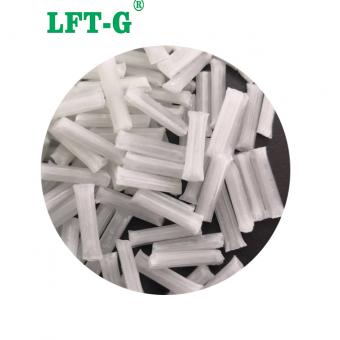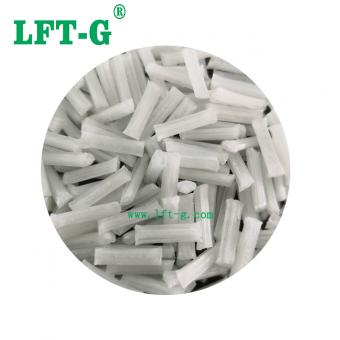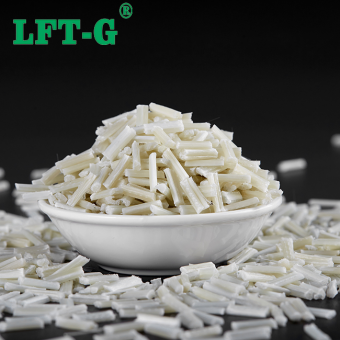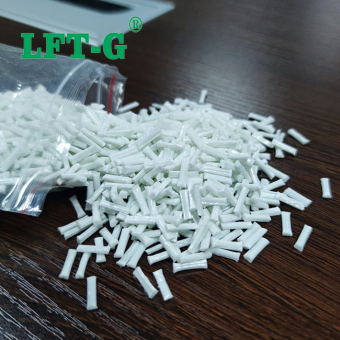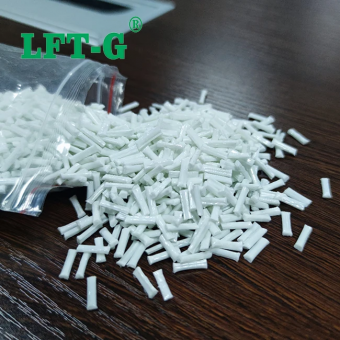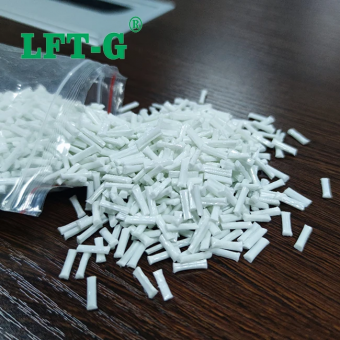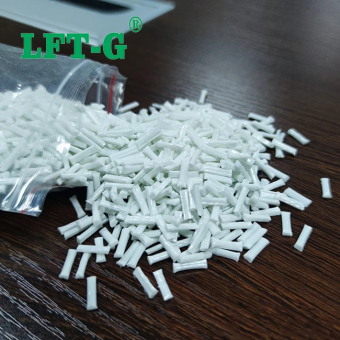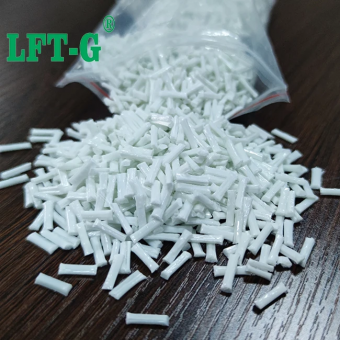-
-
-
PBT充填長ガラス繊維LGF射出グレード複合高品質自然色PBT-LGF Polybutanediol terephthalate (PBT) has excellent comprehensive properties, such as high crystallinity, rapid prototyping, weather resistance, low friction coefficient, high thermal deformation temperature, good electrical properties, excellent mechanical properties, fatigue resistance, can be ultrasonic welding. However, its notched impact strength is low, forming shrinkage rate is large, hydrolysis resistance is poor, easy to be eroded by halogenated hydrocarbons, after glass fiber reinforcement, because of the product longitudinal and horizontal shrinkage is inconsistent easy to warping products. With its excellent comprehensive performance, PBT is widely used in electronic and electrical appliances, automobile industry, machinery, instruments and household appliances and other fields. Common problem & Solvement Glass fiber reinforced PBT material warps easily Reasons: Warping is the result of uneven shrinkage of the material. The warping of the product can be caused by the orientation and crystallization of the components in the material, the improper technological conditions used in the injection molding, the wrong shape and position of the gate in the mold design, and the uneven thickness of the wall in the product design. The warping of PBT/GF composites is mainly due to the fact that the orientation of the glass fiber in the flow direction restricts the shrinkage of the resin, and the induced crystallization of PBT around the glass fiber strengthens this effect, making the longitudinal (flow direction) shrinkage of the product less than the transverse (perpendicular to the flow direction). This uneven shrinkage leads to the warping of PBT/GF composites. Solution: 1. Add minerals and use the shape symmetry of mineral fillers to reduce the anisotropy caused by the glass fiber orientation; 2. Add amorphous materials to reduce the crystallinity of PBT and reduce the uneven shrinkage caused by crystallization, such AS ASA or AS, but they have poor compatibility with PBT, so appropriate compatibilizers need to be added; 3. Adjust injection molding process, such as increasing mold temperature and increasing injection cycle appropriately. Glass fiber reinforced PBT surface floating fiber problem Reasons: The causes of floating fiber are more complex, in short, there are mainly the following aspects 1. The compatibility of PBT and glass fiber is very poor, resulting in the two can not effectively bond together; 2. The viscosity of PBT and glass fiber is very different, resulting in a tendency of separation between the two in the flow process. When the separation effect is greater than the adhesive force, the separation will occur, and the glass fiber will float to the outer layer and leak out; 3. The existence of shear force will not only lead to local viscosity differences, but also destroy the interface layer melt viscosity on the glass fiber surface, the smaller the interface layer is damaged, the smaller the bonding force on the glass fiber. When the viscosity is low to a certain degree, the glass fiber will get rid of the PBT resin matrix and gradually accumulate to the surface and expose. 4. Influence of mold temperature. Due to the low temperature of the mold surface, the glass fiber with light weight and fast condensation is frozen instantaneously. If it is not fully surrounded by melt in time, it will be exposed and form "floating fiber". Solution: 1) Add compatibilizers, dispersants and lubricants to improve the floating fiber problem. For example, the use of special surface treatment of glass fiber, or adding compatibilizers (such as: SOG, a well-flowing PBT modified compatibilizer) through the "bridge" effect, increase the adhesion of PBT and glass fiber. 2) Optimize the molding process to improve the floating fiber problem. Higher injection molding temperature and mold temperature, larger injection molding pressure and back pressure, faster injection molding speed, lower screw speed, can improve the floating fiber problem to a certain extent. The glass fiber reinforced PBT injection molding process is easy to produce more mold scale Reasons: The formation of mold scale is caused by the high content of small molecules or the poor thermal stability of materials. Compared with other materials, PBT is easy to generate mold scale due to its oligomer and small molecule residue rate usually in the range of 1%-3%. And after the introduction of glass fiber, more obvious. This will lead to the continuous processing process, the need to clean the mold regularly, resulting in low production efficiency. Solution: 1) Reduce the amount of small molecule additives (such as lubricant, coupling agent, etc.), try to choose polymer additives; 2) PBT の熱安定性を向上させ、加工中の熱劣化によって生成される小分子生成物を削減します。 PBT アプリケーション 機械、電子・電気、自動車産業、家電などの分野で広く使用されています。 関連もっと見る
-
lft-g PBT 改質材料充填長ガラス繊維 30 高性能オリジナルカラー工業用PBTとは何ですか? ポリブチレン テレフタレート (PBT) は熱可塑性ポリエステルであり、5 つのエンジニアリング プラスチックの 1 つです。 PBTは優れた総合性能を持ち、最も強靱なエンジニアリングプラスチックの一つであり、高い寸法安定性、良好な耐化学腐食性、優れた電気絶縁性、良好な機械的特性と弾性、低吸水性などを備えています。 PBT-LGFとは何ですか? PBT はエンジニアリングプラスチックの 1 つであるため、実用化分野での対応する要件を満たすためにほとんどの PBT を改質する必要があります。PBT改質は主に難燃性PBT、ガラス繊維強化難燃性PBT、ガラス繊維強化PBTに分けられます。 変性PBT材料は主に照明分野(LEDランプシェルなど)、電子・電気分野(リレーシェルやスピナー、ソケット、光ファイバーコネクタなど)、自動車製造分野(ジャンクションボックス、点火系部品、社外ドアハンドル等)。 ガラス長繊維とガラス短繊維の違い 長いガラス繊維の長さは 6 ~ 25 mm ですが、ステープル ファイバーは通常 6 mm 未満、さらには 0.2 ~ 0.6 mm の間です。 ガラス長繊維は機械的性質においてより優れた性能を発揮します。大型製品や構造部品に適しています。短繊維に比べて1~3倍(靭性)が高く、引張強さ(強度・剛性)は0.5~1倍になります。 PBT-LGFの用途は何ですか? 照明業界では、ほとんどのランプシェルは強化難燃性 PBT 素材に使用されており、その性能要件には、加工と成形が容易で、優れた機械的特性、高温および低温サイクル耐性、難燃性レベル UL94 3.0mm または 1.5mm V0 が含まれます。 、高温耐性、黄変防止効果は良好です。その外観には、透明な色または磁器の白い陰影、滑らかな表面、浮遊繊維がないことが必要です。 自動車製造分野では、変性PBTは主に自動車ワイパーブラケット、自動車ヘッドライト照明リング、自動車トランスミッションギアボックス、フロントガラスピラー、モーターシェルなどに使用されています。 TDS は参考のみ 射出成形 私たちに関しては アモイ LFT 複合プラスチック有限公司は、LFT&LFRT に焦点を当てたブランド企業です。長ガラス繊維シリーズ (LGF) および長炭素繊維シリーズ (LCF)。同社の熱可塑性 LFT は、LFT-G 射出成形および押出成形に使用できるほか、LFT-D 成形にも使用できます。お客様のご要望に応じて長さ5~25mmまで製作可能です。同社の長繊維連続浸透強化熱可塑性プラスチックは ISO9001&16949 システム認証に合格しており、製品は多くの国内商標と特許を取得しています。 ぜひご連絡くださいもっと見る
-
アモイLFT PBT改質材料充填長ガラス繊維高性能オリジナルカラーPBTとは何ですか? ポリブチレン テレフタレート (PBT) は熱可塑性ポリエステルであり、5 つのエンジニアリング プラスチックの 1 つです。 PBTは優れた総合性能を持ち、最も強靱なエンジニアリングプラスチックの一つであり、高い寸法安定性、優れた耐化学腐食性、優れた電気絶縁性、優れた機械的特性と弾性、低吸水性などを備えています。 PBT-LGFとは何ですか? PBT はエンジニアリングプラスチックの 1 つであるため、実用化分野での対応する要件を満たすためには、ほとんどの PBT を改質する必要があります。PBT改質は主に難燃性PBT、ガラス繊維強化難燃性PBT、ガラス繊維強化PBTに分けられます。 変性PBT材料は主に照明分野(LEDランプシェルなど)、電子・電気分野(リレーシェルやスピナー、ソケット、光ファイバーコネクタなど)、自動車製造分野(ジャンクションボックス、点火系部品、社外ドアハンドル等)。 ガラス長繊維とガラス短繊維の違い 長いガラス繊維の長さは 6 ~ 25 mm ですが、ステープル ファイバーは通常 6 mm 未満、さらには 0.2 ~ 0.6 mm の間です。 ガラス長繊維は機械的特性においてより優れた性能を発揮します。大型製品や構造部品に適しています。短繊維に比べて1~3倍(靭性)が高く、引張強さ(強度・剛性)は0.5~1倍になります。 PBT-LGFの用途は何ですか? 照明業界では、ほとんどのランプシェルは強化難燃性 PBT 素材に使用されており、その性能要件には、加工と成形が容易で、優れた機械的特性、高温および低温サイクル耐性、難燃性レベル UL94 3.0mm または 1.5mm V0 が含まれます。 、高温耐性、黄変防止効果は良好です。その外観には、透明な色または磁器の白い陰影、滑らかな表面、浮遊繊維がないことが必要です。 自動車製造分野では、変性PBTは主に自動車ワイパーブラケット、自動車ヘッドライト照明リング、自動車トランスミッションギアボックス、フロントガラスピラー、モーターシェルなどに使用されています。 TDS は参考のみ 射出成形 私たちについて アモイ LFT 複合プラスチック有限公司は、LFT&LFRT に焦点を当てたブランド企業です。長ガラス繊維シリーズ (LGF) および長炭素繊維シリーズ (LCF)。同社の熱可塑性 LFT は、LFT-G 射出成形および押出成形に使用できるほか、LFT-D 成形にも使用できます。お客様のご要望に応じて長さ5~25mmまで製作可能です。同社の長繊維連続浸透強化熱可塑性プラスチックは ISO9001&16949 システム認証に合格しており、製品は多くの国内商標と特許を取得しています。 お問い合わせもっと見る
-
LFT-G PBT長ガラス繊維強化熱可塑性樹脂コンパウンドペレットエンジニアリングPBTとは何ですか? ポリジブチルテレフタレートは、ジメチルテレフタレート (DMT) と 1,4-ブタンジオールによって重合された結晶性の熱可塑性エンジニアリング プラスチックです。 PBTは、熱可塑性ポリエステルプラスチックとも呼ばれます。さまざまな加工オペレーターが使用するために、一般に、添加剤の数が追加されたり、他のプラスチックと混合されたり、添加剤の割合が異なり、さまざまな仕様の製品を製造できます。 PBT は、その特殊な特性により、電気工学およびエレクトロニクスにおける特殊な用途に理想的な材料です。 1.機械的特性:高強度、耐疲労性、寸法安定性、クリープも小さい(高温条件下でも変化が少ない) 2.耐熱老化性: UL温度指数120~140℃の強化(屋外長期老化は可能) 3. 耐溶剤性:応力亀裂なし4. 水安定性: PBT は水中で分解しにくい 5. 絶縁性能:優れている (湿潤、高温でも安定した電気的性能を維持できる) グラスファイバーとは何ですか? ガラス繊維 (以前はガラス繊維として知られていました) は、優れた特性を備えた無機非金属材料です。木緑草、珪砂、石灰石、ドロマイト、ホウカルシウム、ホウマイト、7種類の鉱石を原料として、高温溶解、伸線、巻き取り、織りなどの工程で作られます。モノフィラメントの直径は数ミクロンから20ミクロン以上で、髪の毛の1/20~1/5に相当し、各繊維フィラメントは数百、場合によっては数千本のモノフィラメントで構成されています。グラスファイバー製品は、制御可能な範囲内では比較的環境に優しい製品です。 PBT は非常に弱い吸湿性を持っています。非強化PBTの引張強度は50MPa、ガラス繊維強化PBTの引張強度は170MPaです。 PBT は非常に早く結晶化するため、射出成形中に不均一な冷却により部品が曲がったり変形したりしやすくなります。一般的なPBT素材の収縮率は1.5%~2.8%です。 30% ガラス繊維強化された PBT 材料は、0.3% ~ 1.6% 収縮します。 1.耐高温性 試験後、温度が300℃に達しても、ガラス繊維の強度には影響がありません。 2. 高い引張強度 ガラス繊維の引張強度は標準状態で6.3~6.9g/d、湿潤状態で5.4~5.8g/dです。 3. 優れた電気絶縁性 ガラス繊維は電気絶縁性に優れ、断熱材や防火材にも使用される高レベルの電気絶縁材料です。 4. 燃焼 ガラス繊維は高温で溶かしてガラスビーズにすることができるため、建設業界の防火および管理の要件を満たします。 5. 優れた遮音性 ガラス繊維と石膏の組み合わせにより、優れた遮音効果を実現できます。 PBT にガラス繊維を充填したのはなぜですか? PBT にガラス繊維を添加することは、PBT を強化する一般的な方法です。ガラス繊維とPBT樹脂の結合力は良好で、PBT樹脂に一定量のガラス繊維を添加すると、PBT樹脂の耐薬品性、加工性などの本来の利点を維持できるだけでなく、機械的特性も大幅に向上できます。 PBT樹脂のノッチ感受性を克服します。 ガラス長繊維強化PBTコンパウンドの影響 01耐摩耗性 PBTは耐摩耗性に優れており、耐摩擦性や耐摩耗性が求められる場合に有利です。機械伝達部品やベアリングなどの用途では、PBTの耐摩耗性が有効に活用されています。 02機械的特性 PBTは改質後も優れた機械的特性を示します。高い強度と耐疲労性、良好な寸法安定性、低いクリープを備えています。そのため、より大きな負荷に耐え、長期間使用する必要がある部品にはPBTがよく使用されます。 03熱安定性 PBTは熱安定性に優れ、高温条件下でも性能を維持でき、熱分解や変形が起こりにくい素材です。このため、PBT は、電子および電気機器のワイヤ コネクタや絶縁部品など、高温の作業環境に耐えるのに理想的な選択肢となります。 04難燃性 PBTは改質後も優れた難燃特性を有しており、一部の特殊分野の難燃要件を満たすことができます。 UL94 は、材料の難燃特性をテストするための規格です。 PBT エンジニアリング プラスチックの難燃グレードは UL94 V-0 レベルに達することができます。これは、燃焼試験における PBT サンプルの燃焼時間が 10 秒未満であり、燃焼プロセス中に難燃剤が存在しないことを意味します。液だれ現象。このため、PBT成形材料は電子・電�もっと見る
-
幅広い用途に対応する高靭性の新素材LGF PBT当社の長ガラス繊維強化PBTは、高性能熱可塑性複合材料です。PBTの寸法安定性と耐熱性を兼ね備えたと長ガラス繊維の強度と耐久性優れた機械的強度、熱安定性、電気絶縁性が求められる構造部品に最適です。もっと見る
-
長ガラス繊維含有量20~60%のPBT複合ペレットPBT長ガラス繊維強化材料 優れた寸法安定性、高強度、そして抜群の耐薬品性を備えています。耐久性、耐熱性、そして長期的な機械性能が求められる構造部品に最適です。もっと見る
-
PBTペレットガラス繊維PBT GF30 は、優れた性能を提供する高性能熱可塑性複合材料です。 機械的強度と耐熱性 この複合材料は、強化することによって作られます ポリブチレンテレフタレート(PBT) 樹脂入り ガラス繊維30% PBT GF30 は、そのユニークな特性と利点により、さまざまな業界で応用されています。もっと見る

 Eメール
Eメール 日本語
日本語 English
English français
français Deutsch
Deutsch русский
русский italiano
italiano español
español português
português العربية
العربية 한국의
한국의 中文
中文












